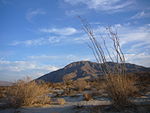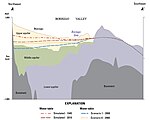El Vado

El Vado campsite (transl. the Ford on the Anza Trail) in the Borrego Valley, Borrego Springs, California in San Diego County, is a California Historical Landmark No. 634 listed on March 3, 1958. The El Vado campsite was a desert camp for the Spanish Commander Juan Bautista de Anza and Father Francisco Garcés expedition of 1775 and 1776. The expedition camped for three days and two nights from December 20 to 22, 1775. At the campsite the expedition rested and watered its stock of mules, cattle, and horses. The expedition passed though the Imperial Valley then though the Colorado Desert, now the Anza-Borrego Desert State Park. The expedition's goal was to start Spanish missions in California and presidio forts though Las Californias to the San Francisco Bay. The expedition route is now the Juan Bautista de Anza National Historic Trail. A historical marker is near the campsite in the desert on Horse Camp Road and Borrego Springs Road in Anza-Borrego Desert State Park. The marker was placed there by the California State Parks Commission working with the Kiwanis Club of Borrego Springs.
Excerpt from the Wikipedia article El Vado (License: CC BY-SA 3.0, Authors, Images).El Vado
Henderson Canyon Road,
Geographical coordinates (GPS) Address Nearby Places Show on map
Geographical coordinates (GPS)
| Latitude | Longitude |
|---|---|
| N 33.30168 ° | E -116.3843 ° |
Address
Henderson Canyon Road 483
92004
California, United States
Open on Google Maps





